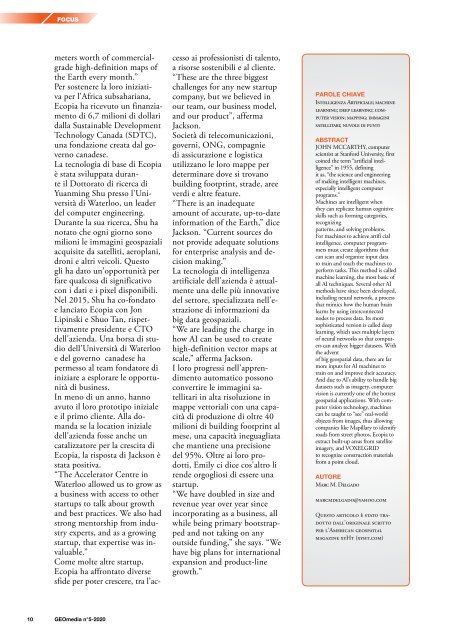GEOmedia_5_2020
La prima rivista italiana di Geomatica
La prima rivista italiana di Geomatica
Create successful ePaper yourself
Turn your PDF publications into a flip-book with our unique Google optimized e-Paper software.
FOCUS<br />
meters worth of commercialgrade<br />
high-definition maps of<br />
the Earth every month.”<br />
Per sostenere la loro iniziativa<br />
per l'Africa subsahariana,<br />
Ecopia ha ricevuto un finanziamento<br />
di 6,7 milioni di dollari<br />
dalla Sustainable Development<br />
Technology Canada (SDTC),<br />
una fondazione creata dal governo<br />
canadese.<br />
La tecnologia di base di Ecopia<br />
è stata sviluppata durante<br />
il Dottorato di ricerca di<br />
Yuanming Shu presso l'Università<br />
di Waterloo, un leader<br />
del computer engineering.<br />
Durante la sua ricerca, Shu ha<br />
notato che ogni giorno sono<br />
milioni le immagini geospaziali<br />
acquisite da satelliti, aeroplani,<br />
droni e altri veicoli. Questo<br />
gli ha dato un'opportunità per<br />
fare qualcosa di significativo<br />
con i dati e i pixel disponibili.<br />
Nel 2015, Shu ha co-fondato<br />
e lanciato Ecopia con Jon<br />
Lipinski e Shuo Tan, rispettivamente<br />
presidente e CTO<br />
dell'azienda. Una borsa di studio<br />
dell'Università di Waterloo<br />
e del governo canadese ha<br />
permesso al team fondatore di<br />
iniziare a esplorare le opportunità<br />
di business.<br />
In meno di un anno, hanno<br />
avuto il loro prototipo iniziale<br />
e il primo cliente. Alla domanda<br />
se la location iniziale<br />
dell'azienda fosse anche un<br />
catalizzatore per la crescita di<br />
Ecopia, la risposta di Jackson è<br />
stata positiva.<br />
“The Accelerator Centre in<br />
Waterloo allowed us to grow as<br />
a business with access to other<br />
startups to talk about growth<br />
and best practices. We also had<br />
strong mentorship from industry<br />
experts, and as a growing<br />
startup, that expertise was invaluable.”<br />
Come molte altre startup,<br />
Ecopia ha affrontato diverse<br />
sfide per poter crescere, tra l’accesso<br />
ai professionisti di talento,<br />
a risorse sostenibili e al cliente.<br />
“These are the three biggest<br />
challenges for any new startup<br />
company, but we believed in<br />
our team, our business model,<br />
and our product”, afferma<br />
Jackson.<br />
Società di telecomunicazioni,<br />
governi, ONG, compagnie<br />
di assicurazione e logistica<br />
utilizzano le loro mappe per<br />
determinare dove si trovano<br />
building footprint, strade, aree<br />
verdi e altre feature.<br />
“There is an inadequate<br />
amount of accurate, up-to-date<br />
information of the Earth,” dice<br />
Jackson. “Current sources do<br />
not provide adequate solutions<br />
for enterprise analysis and decision<br />
making.”<br />
La tecnologia di intelligenza<br />
artificiale dell'azienda è attualmente<br />
una delle più innovative<br />
del settore, specializzata nell'estrazione<br />
di informazioni da<br />
big data geospaziali.<br />
“We are leading the charge in<br />
how AI can be used to create<br />
high-definition vector maps at<br />
scale,” afferma Jackson.<br />
I loro progressi nell'apprendimento<br />
automatico possono<br />
convertire le immagini satellitari<br />
in alta risoluzione in<br />
mappe vettoriali con una capacità<br />
di produzione di oltre 40<br />
milioni di building footprint al<br />
mese, una capacità ineguagliata<br />
che mantiene una precisione<br />
del 95%. Oltre ai loro prodotti,<br />
Emily ci dice cos'altro li<br />
rende orgogliosi di essere una<br />
startup.<br />
“We have doubled in size and<br />
revenue year over year since<br />
incorporating as a business, all<br />
while being primary bootstrapped<br />
and not taking on any<br />
outside funding,” she says. “We<br />
have big plans for international<br />
expansion and product-line<br />
growth.”<br />
PAROLE CHIAVE<br />
Intelligenza Artificiale; machine<br />
learning; deep learning; computer<br />
vision; mapping; immagini<br />
satellitari; nuvole di punti<br />
ABSTRACT<br />
JOHN MCCARTHY, computer<br />
scientist at Stanford University, first<br />
coined the term “artificial intelligence”<br />
in 1955, defining<br />
it as, “the science and engineering<br />
of making intelligent machines,<br />
especially intelligent computer<br />
programs.”<br />
Machines are intelligent when<br />
they can replicate human cognitive<br />
skills such as forming categories,<br />
recognizing<br />
patterns, and solving problems.<br />
For machines to achieve artifi cial<br />
intelligence, computer programmers<br />
must create algorithms that<br />
can scan and organize input data<br />
to train and teach the machines to<br />
perform tasks. This method is called<br />
machine learning, the most basic of<br />
all AI techniques. Several other AI<br />
methods have since been developed,<br />
including neural network, a process<br />
that mimics how the human brain<br />
learns by using interconnected<br />
nodes to process data. Its more<br />
sophisticated version is called deep<br />
learning, which uses multiple layers<br />
of neural networks so that computers<br />
can analyze bigger datasets. With<br />
the advent<br />
of big geospatial data, there are far<br />
more inputs for AI machines to<br />
train on and improve their accuracy.<br />
And due to AI’s ability to handle big<br />
datasets such as imagery, computer<br />
vision is currently one of the hottest<br />
geospatial applications. With computer<br />
vision technology, machines<br />
can be taught to “see” real-world<br />
objects from images, thus allowing<br />
companies like Mapillary to identify<br />
roads from street photos, Ecopia to<br />
extract built-up areas from satellite<br />
imagery, and VOXELGRID<br />
to recognize construction materials<br />
from a point cloud.<br />
AUTORE<br />
Marc M. Delgado<br />
marcmdelgado@yahoo.com<br />
Questo articolo è stato tradotto<br />
dall'originale scritto<br />
per l'American geospatial<br />
magazine xyHt (xyht.com)<br />
10 <strong>GEOmedia</strong> n°5-<strong>2020</strong>


















